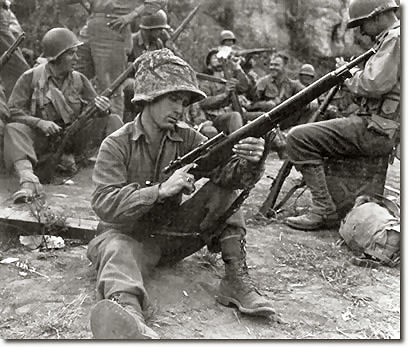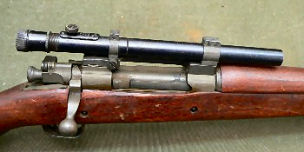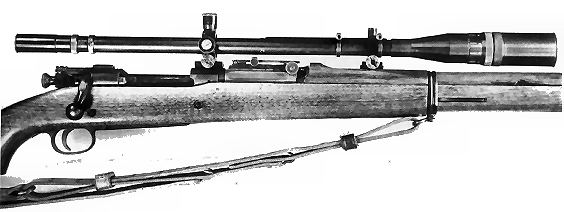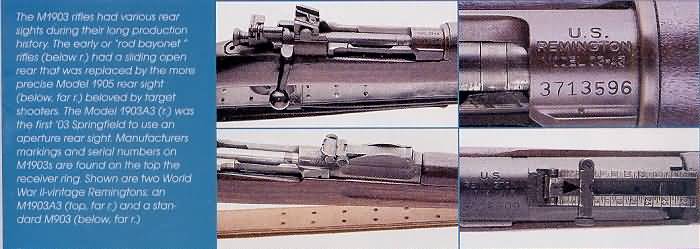From a general historical perspective the year 1903 is perhaps best known for the Wright Brothers' epic flight at Kitty Hawk, N.C. In the history of U.S. military arms, however, 1903 will always be remembered as the year that one of the most venerable service rifles was adopted. Anywone with even a modicum of interest in the subject is aware of the famous "United States Rifle, Caliber .30, Model of 1903," better known to several generations of American shooters and servicemen as the "Springfield '03" or, simply, the '03". No U.S. military service rifle has had a term of service to equal that of the '03. Even though supplemented by large numbers of M1917 "U.S. Enfield" rifles in the World War I, the M1903 remained a significant part of the arsenal of the American Expeditionary Force (AEF) until the Armistice in 1918. "Between the wars," the M1917 was relegated to the war reserve stockpile while the '03 remained the standard rifle in U.S. military service.
In 1936, the semi-automatic MI Garand was standardized. Because the MI was in very short supply until the early 1940s, the '03 remained the predominate American service rifle for almost 40 years and saw front-line combat service through the end of World War II. Even though the standard bolt-action service rifles were largely replaced after World War II, sniping variants of the '03 saw combat use in Korean War — and some even saw issue as late as the Vietnam War. Clearly, the'03 was no "ordinary" military rifle.
The genesis of the MI 903 can be traced to the Spanish-American War of 1898. Regular U.S. Army units were primarily armed with the then-new .30-40 Krag-Jorgensen rifle that was the United States' first bolt-action, smokeless-powder service rifle. Our Spanish adversaries were equipped with late-model Mauser rifles, which had very strong actions and were capable of being clip-loaded. The U.S. Krag, on the other hand, had a bolt with a single locking lug that limited the power of the cartridge, and the Krag was not easily adaptable to clip-loading. The war revealed the Krag's deficiencies and the advantages of the Mauser, which resulted in a reconsideration of the U.S. service rifle.
The U.S. Army Ordnance Department evaluated the Mauser rifle and fabricated several prototypes based heavily on the design. Extensive testing revealed that the modified Mauser design was a great improvement over the Krag, and, on June 19, 1903, the "United States Magazine Rifle, Caliber .30, Model of 1903" was approved for adoption as the standard U.S. military service rifle. It had a 24" barrel that allowed it to be used by both the infantry and the cavalry, thus eliminating the need for separate rifles and carbines.
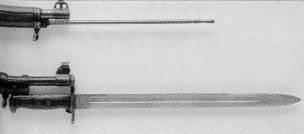
The M1903 was initially chambered for the "Model 1903" cartridge, typically known as the ".30-03.".This rimless ,30-cal. round was more powerful than its predecessor but caused severe bore erosion. It was also fitted with a rather flimsy sliding "rod bayonet."
The M1903 was put into production at Springfield Armory and Rock Island Arsenal. Rock Island experienced some delays, but the rifles were soon flowing from Springfield's assembly line. Nonetheless, problems were encountered with the rod bayonet and the hot-burning .30-03 cartridge. President Theodore Roosevelt was a particular opponent of the rod bayonet concept and called the device "... about as poor an invention as I ever saw." In early 1905, '03 production stopped in order to redesign the rifle to eliminate the troublesome rod bayonet and adapt it to a knife bayonet. The "Bayonet, Model 1905" was adopted in April 1905. The cessation of production was also utilized to develop improved sights, which were adopted and given the "Model of 1905" designation.
Although some 74,000 of the original rod bayonet '03s had been manufactured, only a relatively few had been issued. Most of the original "rod bayonet" rifles were recalled to be retrofitted for the new M1905 knife bayonet and sights, and production with the "1905 improvements" resumed.
Problems with the .30-03 resulted in production again being halted in order to adopt a new cartridge. The .30-03 had a round-nose bullet eventually proven to be inferior to the sharp-pointed German-developed "spitzer" bullet. In October 1906, a vastly improved cartridge with a "spitzer" bullet and reformulated powder to reduce the .30-03's severe bore erosion was adopted as the "Cartridge, Ball, Caliber .30, Model of 1906," now widely known as the ".30-'06." Existing barrels were rechambered for the new cartridge and all subsequent M1903s were in .30-'06.
With the modifications of 1905 and the adoption of the .30-'06, the M1903 was in the general configuration that would be in production at varying levels for almost 40 years. From the time of its adoption until World War I, the M1903 was manufactured with a craftsmanship rivaling the best custom-made sporting rifles of the era. The wood-to-metal fit and overall quality were superb, and the rifles featured finely blued metal parts and f lawlessly Grafted wooden stocks.
By about 1911, all branches of the U.S. armed forces were primarily armed with M1903s.The accuracy, fire-power and reliability of the '03 soon made it very popular with the majority of its users. The '03 also proved its mettle as a competitive target rifle as well, including use in Olympic matches. The first standard-issue U.S. Army sniper rifle, an M1903 fitted with a prismatic Warner & Swasey Model of 1908 "Musket Sight" was adopted during this period. Prior to World War I, the M1908 W&S sight was replaced by the slightly improved M 1913 variant, which was the primary U.S. sniping arm of the war. The U.S. Marine Corps did not adopt the Warner & Swasey scope and, rather, utilized M1903s fitted with Winchester A-5 scopes.
By WorldWar I, the M1903 was firmly entrenched as the standard American military service rifle. Rock Island had previously stopped production after 1913, and the '03 remained in limited production at Springfield. Just prior to America's entrance into the war, manufacture of the '03 was greatly increased at Springfield and resumed at Rock Island. It was soon apparent that their combined production would be insufficient to arm the rapidly expanding armed forces. A slightly modified version of the British Pattern 1914 rifle was adopted as a supplemental service rifle and given the designation "U.S. Rifle, Caliber .30, Model of 1917." The M1917 was made in much larger numbers than the '03 during World War I, and, by the time of the Armistice, the majority of the AEF was armed with the "American Enfield." Even so, the '03 saw widespread use during the World War land provided excellent service to our "Doughboys."


